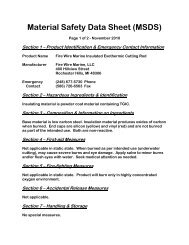Instruction Manual - Amron International Inc.
Instruction Manual - Amron International Inc.
Instruction Manual - Amron International Inc.
You also want an ePaper? Increase the reach of your titles
YUMPU automatically turns print PDFs into web optimized ePapers that Google loves.
MAINTENANCEPROBLEMS AND THEIR POSSIBLE CAUSES (continued) 8.4Diver Hears Tender But Tender Cannot Hear Diver, Or Volume Is Very LowCheck to see if diver is connected to microphone and not earphone. Check to see that volumelevels are not turned down. Inspect diver connections, hat components.Feedback - SimulcomCheck orientation of cable wiring, earphone and microphone wire pairs should be opposing wires.These situations may cause feedback, tender’s speaker on while headset is connected, unuseddiver communications connected to system, damaged communications cable or connections,(open or shorted wires or connections). Resistance for a new cable should be in excess of 10 Megohms.In a situation where the communication cable is damaged, reduce volume to diver as low aspossible (reduce side-tone), or go to 2-wire operation until cable can be repaired.Feedback can be caused by leakage between the microphone and earphone wires in the umbilicalbetter know as a cross coupling signal between umbilical wires. Adjust the diver microphonevolume to determine which umbilical has cross coupling signal between wires. Rotate theearphone banana plug (black) 180 degrees on the communicator as this it may stop the feedback.We highly recommend using <strong>Amron</strong>’s CC1 communication cable that has been specially designedand tested for use with our communicators.DistortionThis can be caused by several conditions – microphone volumes is adjusted too high, system ison the verge of feedback, marginal components (earphones or microphone). Check bysubstitution, replace defective component. Note: when operating with a standby diver who doesnot have his hat/helmet on, acoustic feedback or distortion may occur. Correct by turning hisvolume down or disconnecting his communication cable (at least his microphone, which willreduce overall system noise.).Low Battery IndicationIf battery voltage is low, charge batteries for a minimum of 24 hours to fully charge battery. Batterywill charge anytime the unit is plugged into the AC line, make sure the AC power circuit being usedis not switched off at night. The preferred method to charge the battery is with power off. Thecharger circuit is designed to maintain the battery at full charge during normal operation, andpower can be left on without damage to the battery.The battery voltage can be checked by measuring across the yellow jacks on the front panel. Turnthe unit on; if the unit is plugged into the AC line, the measurement will be the output of the batterycharger. To measure the battery voltage, disconnect the unit from the AC line.The voltage at full charge with the charger on should be between 13.0 and 14.0 volts. With thecharger off, a fully charged battery should be between 11.75 and 12.5 volts. The battery voltage ofa discharged battery (rechargeable) is 10.0 volts; the battery should not be operated below thispoint as permanent damage will occur. The rechargeable batteries used in the <strong>Amron</strong>communicators are a gel cell design.35



